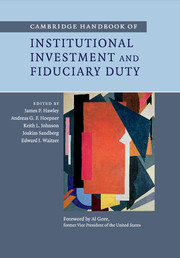Book contents
- Frontmatter
- Contents
- List of figures
- List of tables
- List of contributors
- Foreword
- 1 Introduction
- Part I Fiduciary duty: a global outlook
- Part II Fiduciary duty and the landscape of institutional investment
- Part III Challenging conventional wisdom on fiduciary duty
- Part IV Towards a broader interpretation of fiduciary duty
- 20 Fiduciary duty and the search for a shared conception of sustainable investment
- 21 Pension fund fiduciary duty and its impacts on sustainable investing
- 22 Reason, rationality and fiduciary duty
- 23 Socially responsible investment and the conceptual limits of fiduciary duty
- 24 Fiduciary duty at the intersection of business and society
- 25 Challenging conventional wisdom: the role of investment tools, investment beliefs and industry conventions in changing our interpretation of fiduciary duty
- Part V Beneficiaries’ roles and viewpoints
- Part VI Fiduciary duty and governance
- Index
- References
25 - Challenging conventional wisdom: the role of investment tools, investment beliefs and industry conventions in changing our interpretation of fiduciary duty
Published online by Cambridge University Press: 05 April 2014
- Frontmatter
- Contents
- List of figures
- List of tables
- List of contributors
- Foreword
- 1 Introduction
- Part I Fiduciary duty: a global outlook
- Part II Fiduciary duty and the landscape of institutional investment
- Part III Challenging conventional wisdom on fiduciary duty
- Part IV Towards a broader interpretation of fiduciary duty
- 20 Fiduciary duty and the search for a shared conception of sustainable investment
- 21 Pension fund fiduciary duty and its impacts on sustainable investing
- 22 Reason, rationality and fiduciary duty
- 23 Socially responsible investment and the conceptual limits of fiduciary duty
- 24 Fiduciary duty at the intersection of business and society
- 25 Challenging conventional wisdom: the role of investment tools, investment beliefs and industry conventions in changing our interpretation of fiduciary duty
- Part V Beneficiaries’ roles and viewpoints
- Part VI Fiduciary duty and governance
- Index
- References
Summary
Introduction
This chapter explores the link between investment tools, investment beliefs and industry conventions to the interpretation of fiduciary duty. There is no hard rule about what is, or is not, in the best interest of beneficiaries and as such, it will always come down to judgment. It is interesting to see over recent years the beliefs that underpin investment decisions being challenged and evolving to support a long-term investment horizon and the integration of environmental, social and governance (ESG) factors into decision-making. This chapter argues that a combination of new tools, evolving beliefs and industry conventions are integral to supporting a wider interpretation of fiduciary duty. While some challenges remain in applying new tools and moving from beliefs into action, the building blocks are in place for change to be meaningful and sustained.
Current investment theory and the interpretation of fiduciary duty
Trustees have a fiduciary duty, or legal responsibility, to act in the best interests of their beneficiaries. “Acting in the best interest” is about ensuring that beneficiaries’ interests are protected and enhanced by the trust. If beneficiaries believe that their best interests have not been protected or enhanced, trustees can be sued for a breach of fiduciary duty and potentially held liable. Many trustees in pension funds and charities don’t have specialist investment knowledge and there is generally no legal requirement for them to do so in most countries. For example, in the UK there is only the requirement that they “obtain proper advice” (Myners Review 2001: 5). As a result, most trustees rely heavily on external advice from investment consultants and internal investment executives who advise on strategy and manager selection.
- Type
- Chapter
- Information
- Publisher: Cambridge University PressPrint publication year: 2014



